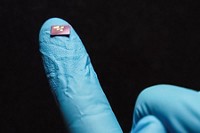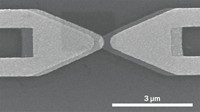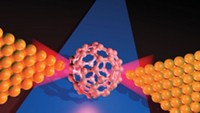Advertisement
Grab your lab coat. Let's get started
Welcome!
Welcome!
Create an account below to get 6 C&EN articles per month, receive newsletters and more - all free.
It seems this is your first time logging in online. Please enter the following information to continue.
As an ACS member you automatically get access to this site. All we need is few more details to create your reading experience.
Not you? Sign in with a different account.
Not you? Sign in with a different account.
ERROR 1
ERROR 1
ERROR 2
ERROR 2
ERROR 2
ERROR 2
ERROR 2
Password and Confirm password must match.
If you have an ACS member number, please enter it here so we can link this account to your membership. (optional)
ERROR 2
ACS values your privacy. By submitting your information, you are gaining access to C&EN and subscribing to our weekly newsletter. We use the information you provide to make your reading experience better, and we will never sell your data to third party members.
Photonics
Metamaterials allow researchers to shrink a synchrotron onto a chip
An optical chip smaller than a penny can produce terahertz radiation, with potential applications in spectroscopy
by Katherine Bourzac
October 25, 2018
| A version of this story appeared in
Volume 96, Issue 43
Chemists, biologists, and other scientists travel across the globe to football field-size synchrotron facilities to use the brilliant light the machines emit for various spectroscopic experiments, including X-ray crystallography. Now researchers report that a photonic device that relies on metamaterials can bend light and generate terahertz radiation, acting as a minuscule synchrotron on a chip. With further development, researchers hope their compact synchrotrons will provide pure, bright beams of terahertz radiation for imaging and spectroscopy (Science 2018, DOI: 10.1126/science.aat5915).
Synchrotron radiation is light that is generated when strong magnets direct charged particles to speed around a circular path. In typical synchrotrons, electrons race around a magnetic track and emit X-rays. Light itself can’t produce synchrotron radiation because photons have no charge, but it can be made to move in circles. University of Michigan, Ann Arbor, physicist Roberto Merlin wondered whether he could use the way that this circling light interacts with certain materials to indirectly produce synchrotron radiation in a much smaller space than that of the typical big-science synchrotron machines.
To make it work, he turned to a kind of material called a metasurface. Instead of lenses, researchers can use intricately patterned thin films of metal with dimensions smaller than the wavelength of light to coax incident light beams to bend in strange ways—even sending them swirling in a circle. With the right dimensions and designs, metasurfaces can “completely control the light field,” says Meredith Henstridge, who led the synchrotron-on-a-chip project as a grad student and is now a postdoc at the Max Planck Institute for the Structure & Dynamics of Matter.
The group chose to produce terahertz radiation because of its applications. Terahertz frequencies fall between microwaves and infrared light and are used to detect weapons and drugs under people’s clothing in airport security scanners. The radiation also has growing applications in spectroscopy for studying polymer elasticity, the behavior of semiconductors, and other dynamic material properties.
Merlin and Henstridge worked with researchers at Purdue University to design and fabricate 0.5-mm2 arrays of 10 million 100-nm-long, boomerang-shaped gold antennas atop slices of lithium tantalate crystal. When the researchers shine an IR laser on the patterned crystals, the light travels in an arc above the metasurface. The interaction between the light and the nanoantennas induces what Henstridge calls “a blob of positive and negative charges” inside the crystal. It’s the movement of these charges that causes synchrotron radiation—in this case, in the terahertz band.
At the moment, the radiation produced by the synchrotron on a chip is akin to the output of a lightbulb—a mix of frequencies. Merlin says this first design is a proof of principle, and now he plans to upgrade it so that the light will travel in a full circle and continue circulating—just like charges do in a conventional synchrotron. With this upgrade, he says, it should be possible to produce a source that emits beams of pure terahertz frequencies, which are needed for spectroscopic methods.
Charles Schmuttenmaer, a Yale University chemist who uses terahertz spectroscopy to study molecular crystals and semiconductors, says the work is provocative. However, he would like to see follow-up studies to confirm the phenomenon of synchrotron radiation.





Join the conversation
Contact the reporter
Submit a Letter to the Editor for publication
Engage with us on Twitter